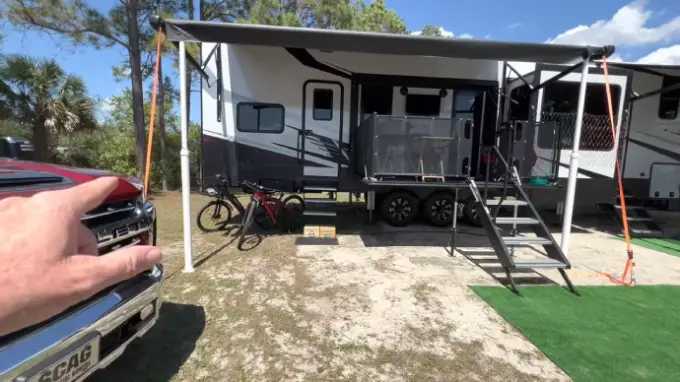Last Updated on April 20, 2023
RV awnings are a great way to provide shade and shelter for outdoor adventures. However, it’s important to understand how much wind your RV awning can withstand.
Enjoy your camping adventures confidently, knowing most RVs and awnings are built to withstand high winds as strong as 20-25 mph. Thid awning helps guard against Mother Nature’s harsh elements.
Several factors, such as material quality and design, size and type of awning, and angle of inclination, all impact the wind resistance of an awning. It is also important to follow the manufacturer’s recommendations for testing and safety precautions when dealing with high winds.
Knowing how much wind your RV awning can handle can give you peace of mind and help ensure an enjoyable outing without worrying about the weather conditions. Find out what you need to know about the wind resistance of RV awnings.
How Much Wind Can an RV Awning Withstand: Factors Affecting
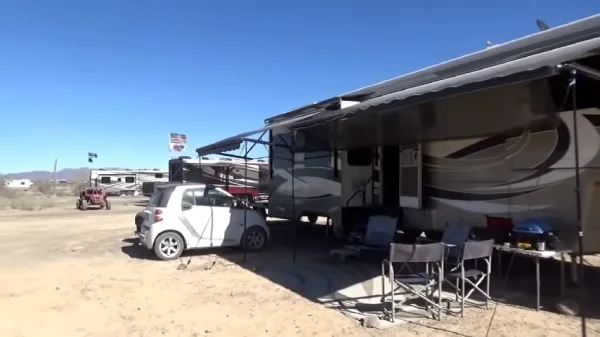
The wind resistance of an RV awning is affected by several factors. Here are some of the most important ones:
Material Quality and Design
An RV awning’s material quality and design are crucial in determining its wind resistance. The material type used, construction, and overall design can all impact how well the awning will hold up against strong winds.
Most RV awnings are made from either vinyl or acrylic fabric. Vinyl is typically less expensive but may not be as durable as acrylic, which tends to be more resistant to wear and tear.
Additionally, how the fabric is woven can affect its wind resistance. For example, a tighter weave may provide better protection against the wind than a looser weave.
The design of the awning frame also plays a role in its wind resistance. Some frames are designed to be sturdier than others, with thicker poles or additional supports that provide added stability. Awnings with curved or domed shapes may also be more wind-resistant than those with flat designs.
Size and Type of Awning
Regarding wind resistance, the size and type of RV awning you have can make a big difference. The wind may cause greater damage to larger awnings than to smaller ones, but other factors also need to be taken into account.
Firstly, the type of awning matters. Automatic and manual RV awnings are the two main types. Manual awnings are operated by hand using a crank or lever, while automatic awnings extend and retract with the push of a button.
Automatic awnings are more sturdy and secure in windy conditions because they have built-in sensors that detect when wind speeds get too high and automatically retract the awning.
In terms of size, longer and wider RV awnings are generally more prone to wind damage because they create more surface area for the wind to catch onto. However, this doesn’t mean smaller RV awnings are immune to wind damage.
Even a small gust of wind can cause an improperly secured or poorly designed RV awning to become damaged or even detached from the vehicle.
Angle of Inclination
The angle of inclination is an important factor in determining the wind resistance of your RV awning. When setting up your awning, it’s important to ensure it’s at the proper angle to withstand any potential wind gusts.
Most RV awnings are designed to be set up at a slight angle, usually between 5 and 15 degrees. This helps to create a slope that allows water to run off the top of the awning, preventing pooling and potential damage from heavy rain.
However, the angle of inclination also plays a role in the awning’s wind resistance. If your awning is too flat, it will catch more wind and will likely get damaged or even ripped off by strong gusts. On the other hand, if it’s too steep, it may not withstand lateral pressure from high winds.
To determine the optimal angle for your RV awning, consult your manufacturer’s recommendations or seek advice from an experienced RV owner or technician. You can also experiment with different angles and observe how well your awning holds up during windy conditions.
Understanding Wind Speed Measurement
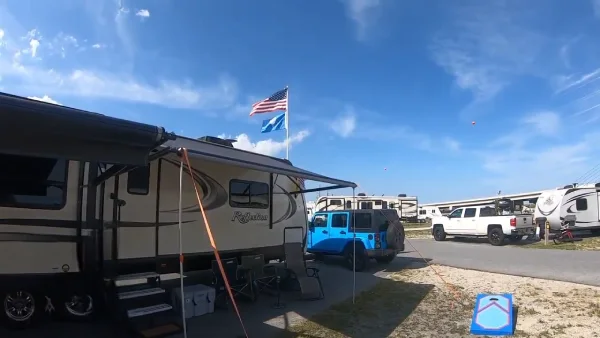
Wind speed is crucial in determining an RV awning’s wind resistance. Before we dive into how RV awnings measure wind resistance, it’s essential to know how it’s measured.
How Wind Speed is Measured
The National Weather Service uses anemometers to measure wind speed and devices that use cups or propellers to capture the force of the wind. These measurements are taken at the height of 33 feet above the ground, which is considered the standard height for wind measurement.
The Beaufort Scale, developed by British admiral Sir Francis Beaufort in 1805, is commonly used to classify wind speeds. The scale ranges from 0 to 12 and is based on observations of how wind affects different objects, such as trees, water surfaces, and buildings.
For example, a wind speed of 0 on the Beaufort Scale corresponds to calm air with no movement, while a wind speed of 12 corresponds to hurricane-force winds that can cause widespread damage.
In general, RV awnings can withstand winds up to around 20 mph (32 km/h) without any issues. However, this can vary depending on several factors.
It’s important to note that wind gusts can be much stronger than sustained winds and can cause sudden damage even if sustained winds are within safe limits. Therefore, it’s recommended that you pay attention not only to sustained winds but also gusts when estimating your RV awning’s wind resistance.
Beaufort Scale: Wind Speed Classification
The Beaufort Scale is a system used to measure wind speed and its effects on the environment. It was developed in the early 1800s for British admiral Sir Francis Beaufort to describe wind conditions at sea.
Today, it is widely used by meteorologists and sailors alike to estimate wind speed based on observed conditions.
The scale ranges from 0 to 12, with each number corresponding to a specific range of wind speeds and their associated effects. At the lower end of the scale, calm winds are classified as 0; at the higher end, hurricane-force winds are classified as 12.
Here’s a breakdown of each level of the Beaufort Scale:
- 0 – Calm: Winds are less than 1 mph (1.6 kph), and smoke rises vertically.
- 1 – Light Air: Winds are between 1-3 mph (1.6-4.8 kph), and smoke drifts slightly.
- 2 – Light Breeze: Winds are between 4-7 mph (6.4-11.3 kph), and leaves rustle.
- 3 – Gentle Breeze: Winds are between 8-12 mph (12.9-19.3 kph), and small twigs move.
- 4 – Moderate Breeze: Winds are between 13-18 mph (20.9-29 kph), and dust or lose paper blows around.
- 5 – Fresh Breeze: Winds are between 19-24 mph (30.6-38.6 kph), and small trees sway.
- 6 – Strong Breeze: Winds are between 25-31 mph (40.2–49.9 kph), and large branches move.
- 7 – Near Gale: Winds are between 32–38 mph (51.5–61.1 kph), and whole trees sway.
- 8 – Gale: Winds are between 39–46 mph (62.7–74 kph), and branches break off trees.
- 9 – Strong Gale: Winds are between 47–54 mph (75.6–86.9 kph), and slight structural damage occurs.
- 10 – Storm: Winds are between 55–63 mph (88.5–101.4 kph), and trees are uprooted.
- 11 – Violent Storm: Winds are between 64–72 mph (103–116 kph), and widespread damage occurs.
- 12 – Hurricane Force: Winds are over 73 mph (117 kph), and catastrophic damage occurs.
It’s important to note that the wind speed ranges in the Beaufort Scale are estimates, as actual wind speeds can vary based on local conditions. However, understanding the scale can help RV owners decide when to retract their awnings or take other precautions during high winds.
Estimating Your RV Awning’s Wind Resistance
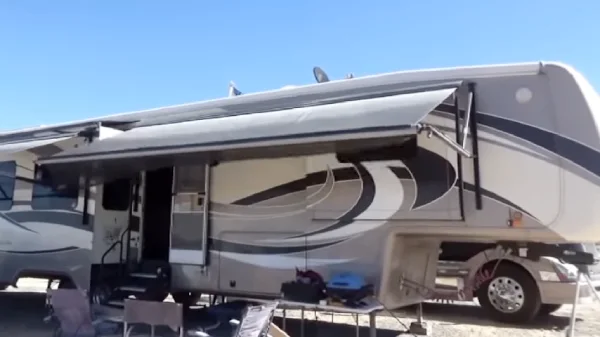
Estimating your RV awning’s wind resistance is essential to prevent any potential damage caused by high winds. There are two ways to estimate your RV awning’s wind resistance: following the manufacturer’s recommendations or testing it yourself.
Manufacturer’s Recommendations
The manufacturer’s recommendations are essential when determining how much wind an RV awning can withstand. The manufacturer will have tested the awning and should provide guidelines for safe usage.
It is important to note that these recommendations may differ depending on your RV awning’s specific make and model. Therefore, referring to the owner’s manual or contacting the manufacturer directly for their specific recommendations is crucial.
Generally speaking, most RV awnings are designed to withstand winds of up to 10-15 mph. However, it is essential to note that this is a general guideline, not a guarantee. Wind gusts can be unpredictable, and even a slight increase in wind speed can cause damage to your awning.
Testing Your Awning’s Wind Resistance
Testing your RV awning’s wind resistance is relatively easy and can be done with just a few simple steps. First, make sure that your awning is fully extended and secured in place.
Then, gradually increase the wind speed by using a fan or leaf blower. Keep increasing the speed until you reach the maximum recommended wind speed for your awning.
It’s important to note that different types of awnings will have different maximum wind speeds, so check with your manufacturer for specific guidelines. Additionally, it’s always better to err on caution and not exceed the recommended wind speed.
Precautions to Take During High Winds
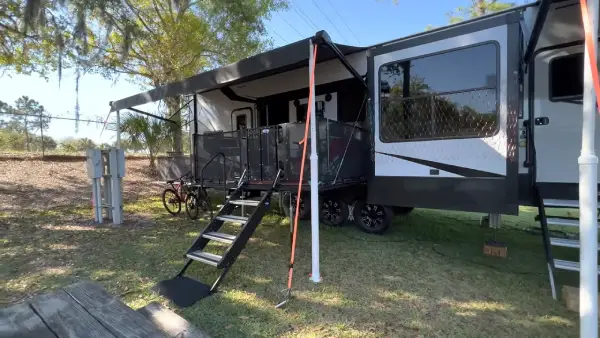
During high winds, it is important to take precautions to ensure your RV awning does not become damaged or cause harm. Two main precautions are retracting the awning and securing it with tie-downs.
Retracting the Awning
Retracting the awning is one of the most important precautions during high winds. Retracting the awning can prevent RV damage and avoid potential safety hazards if wind speeds exceed the recommended limit.
Before retracting your awning, it’s important to ensure all items underneath are secured or removed. This includes outdoor furniture, grills, and any other loose objects that high winds could blow away.
To retract your awning, follow these steps:
- Turn off any electrical devices connected to the awning.
- Release any tension on the arms of the awning.
- Press and hold the retract button until the awning is fully closed.
- Securely lock the arms in place.
It’s also important to note that retracting your RV awning doesn’t necessarily mean you’re safe from high winds. In extreme cases, even a retracted awning can be damaged or cause damage if it’s not properly secured.
Therefore, it’s recommended that you secure your retracted awning with tie-downs or straps. This will help prevent it from flapping around in windy conditions and causing damage to your RV.
Securing the Awning with Tie-Downs
When camping in an RV, taking precautions during high winds is important to prevent damage to your awning. One way to secure your awning is by using tie-downs.
Tie-downs are straps or ropes that attach the awning to the ground or nearby objects, providing extra support and stability. They distribute the wind force evenly across the entire awning length, reducing the risk of damage.
When selecting tie-downs, make sure they are made of sturdy and durable materials such as nylon or polyester. Avoid using ropes that can easily fray or break under pressure. It is also important to choose tie-downs that are long enough to provide sufficient tension without causing any damage to the awning’s fabric.
To secure your awning with tie-downs, follow these steps:
- Find a suitable anchor point for each tie-down. This can be a nearby tree, a stake in the ground, or a heavy object like a rock.
- Attach one end of each tie-down to the anchor point and the other end to the corresponding loop on the awning.
- Adjust the tension on each tie-down until it feels firm but not too tight.
- Check periodically for any signs of wear or tear on both the tie-downs and the awning fabric.
It is important to note that while tie-downs can help secure your awning during moderate winds, they may not be enough during severe weather conditions such as hurricanes or tornadoes. In those cases, it is best to retract your awning completely and seek shelter in a safe location.
Pull-in Slide Outs:
You need to do this when RVing during high winds to pull in all of your slide-outs. This will help to stabilize your RV and make it less likely that something will come loose and fly off. You may also want to consider getting some tie-downs to secure your RV.
In addition, it’s a good idea to avoid using awnings during high winds as they can easily be damaged or torn off. If you have any outdoor furniture, it’s best to bring it inside.
Close All Vents and Windows:
When high winds are forecast, you should shut all windows and vents on your RV. This helps stabilize the vehicle and prevent wind damage aerodynamically. If you have a retractable awning, it’s also a smart idea to roll it up to avoid wind damage. You should also secure all loose objects that can get caught up in the wind.
Among these are bicycles, chairs, and barbecues. In addition, you should also secure any loose items on the exterior of your RV, such as the window awning or chairs.
Point the Trailer Nose Towards the Wind:
Pointing the trailer nose into the wind helps prevent the wind from catching under the trailer and potentially flipping it over. This is especially important when camping in high winds. If you are unsure which way the wind is blowing, you can check by looking at the flags on nearby campers or buildings.
When you’ve determined the direction of the wind, point your trailer’s nose toward the wind. This will help stabilize your trailer and prevent it from being overturned by strong wind gusts. The trailer nose will also be less stressed and easier to control if pointed into the wind.
Of course, this isn’t always perfectly possible or practical, so use your best judgment and be prepared to make adjustments as necessary. Ultimately, the goal is to keep the trailer as stable as possible in high winds.
Fill Fresh Water and Waste Tanks:
Any experienced RVer knows that the first thing to do when setting up camp is to fill the potable drinking water and waste tanks. This provides you with the necessary resources for cooking, cleaning, and bathroom use, but it also helps stabilize the RV in high winds.
The water’s extra weight helps keep the RV from being blown around, and if you happen to lose power, you’ll have access to clean water. Additionally, it’s always advisable to empty the black water tank before a storm hits. This helps to prevent sewage backup if the RV gets rocked by strong winds.
Choosing a Safe Campsite
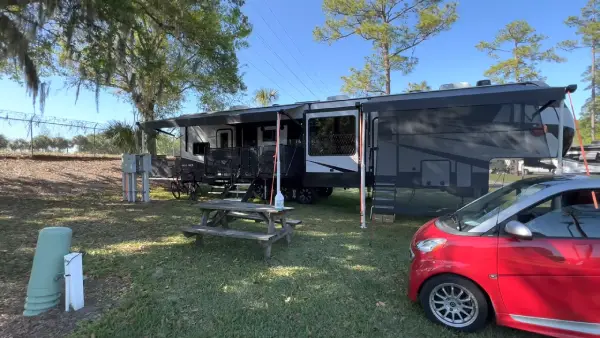
When choosing a campsite for your RV, wind resistance is an important factor to consider. You want to ensure that your chosen location will not put your awning at risk of damage from high winds.
To start, look for a site that is sheltered from the wind. This could mean parking your RV near trees or other natural barriers that can block the wind. Additionally, try to park your RV so that the direction of the wind is hitting the side of your vehicle instead of directly hitting the awning.
It’s also important to pay attention to weather forecasts and avoid setting up camp during periods of high winds. If you do find yourself in a situation where high winds are expected, take precautions such as retracting your awning or securing it with tie-downs.
Lastly, be mindful of any potential hazards in the area, such as loose branches or debris that could become dangerous projectiles in high winds. Taking these precautions and being aware of wind resistance factors when choosing a campsite can help ensure your RV awning stays safe and secure during your travels.
Security Methods for RV Awning in High Wind Speed
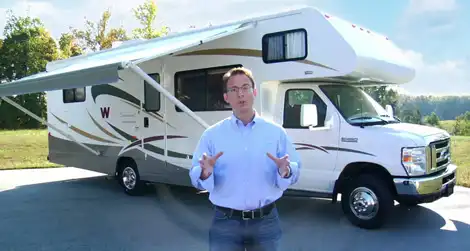
There are rules about putting out awnings at high wind speed on many RV grounds. It is because awnings can act like sails when the wind blows, pulling the RV away from its parking spot or even tipping it over. A sound awning security system can prevent this from happening.
Here are some appliances you can use how to protect RV awning from wind:
01. RV Awning Clamp (De-flapper clamps):
RV Awning Clamps are commonly used to help secure RV awnings at high wind speeds. Several different RV Awning Clamps are available on the market, but the most common and popular type is the De-flapper clamp.
These clamps attach to the leading edge of the awning and help to hold it in place. With the ability to adjust the clamps to fit different fabric thicknesses, they are ideal for RV awnings of all kinds. In addition, you don’t have to worry about leaving them behind when you pitch your tent.
02. Awning Stabilizer Kit:
Awning stabilizer pole kits are available online and at most RV dealerships. Generally, the kit consists of two or more support arms attached to the RV and tie-down straps or ropes. If necessary, you can also use them to secure other objects, including umbrellas and chairs, to the awning.
To set up the stabilizer:
- Extend the support arms and secure them to the RV.
- Attach the tie-down ratchet strap or rope to the stabilizer arms and then to sturdy objects on the ground, such as trees, picnic tables, or vehicle tires.
This will protect the electric awning from moving around in high winds. Awning stabilizer kits are affordable to add extra protection to your RV awning and can be easily set up and taken down as needed. Awning kits typically include stakes and Guy lines for anchoring them to the lawn.
03. Bungee Straps:
Bungee Straps are an essential security measure for any RV owner. They maintain the awning’s position during high wind speeds, providing an extra layer of protection against thieves. These straps are made from a solid elastic material that can withstand force.
They’re typically used to secure heavy objects or tie-down large items. The awning won’t blow away in high winds. Bungee straps are available at hardware stores. RV owners should always have a few on hand in case of emergencies.
04. Guy Lines:
Guy lines are an essential part of any caravan awning set-up, but they need to be appropriately used to be effective. These lines are typically positioned at the four corners of the awning, and they can be made from a variety of materials, including rope, bungee cord, or even webbing.
For using these lines:
- Ensure that the lines are made of a strong material that can withstand high winds.
- Attach the lines to the fabric at several points, using either loops or clamps. This will help distribute the awning’s weight and guard it against being pulled down by the wind.
- Secure anchoring of the lines is essential. This will prevent them from being blown away by the wind or pulled loose by the awning.
Once in place, the guy lines help to stabilize the acrylic awning and keep it in place during strong winds.
Can I leave my RV awning out in the wind?
Leaving an RV awning out in the wind is not recommended, as it can cause damage. Wind can cause the awning to collapse and may also result in the tearing of the fabric.
To avoid such scenarios, it is best to lower the manual awning to ground level when not in use and ensure that it is stable on breezy days. When done using the awnings, ensure they are completely dry before rolling them up to prevent mold and mildew growth on them.
Are awnings suitable for windy areas?
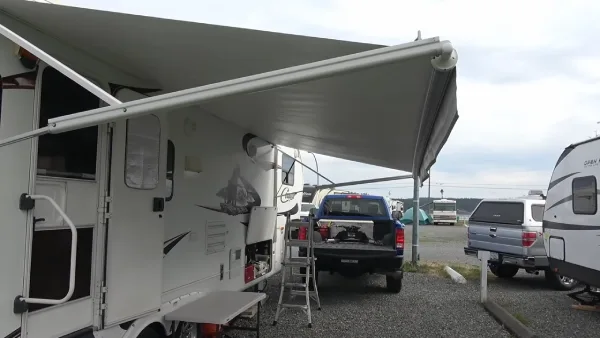
Awnings are a practical option for protecting against bad weather in windy areas. Metal or retractable awnings constructed from durable materials offer significant protection from winds of up to 80 mph.
It is important to consider the material, design, and wind resistance rating when selecting an awning for these areas. For maximum protection, consult with a professional installer who can properly anchor and secure the awning according to your area’s conditions.
Are awnings able to withstand heavy rain?
While most standard domestic or commercial-grade awnings offer partial rain protection, they should not be considered completely waterproof solutions during heavy rain.
Awnings should be folded back if heavy rains persist over extended periods so as to prevent any damage caused by water pooling at their center points due to poor runoff angles.
Light rain awnings like Venezia by RetractableAwnings.com are designed specifically for decks and provide more protection against light rains than other types of standard domestic grade or commercial grade models do.
How Do I Keep My Awning From Blowing Away?
You can help prevent your awning from getting blown away by creating a windbreak. This will require some sturdy poles. Rope or bungee cords will be needed to secure the poles to the ground. This will create a barrier to deflecting strong wind gusts away from your awning.
Can I Leave My RV Awning Out in the Wind?
It’s not advisable to leave your RV awning exposed to the wind. If you must do so, make sure it’s properly secured and never leave it unattended. High winds can damage or destroy an unsecured awning, and you don’t want to be held responsible for any property damage or injuries that may result.
How Does an Awning Wind Sensor Work?
An awning wind sensor works by sensing wind-generated movement. This allows the awning to be opened or closed automatically in response to changes in the weather, which helps keep it protected from the elements.
Shield Your RV with Careful Awning Maintenance
Knowing the wind resistance of your RV awning is essential for any outdoor enthusiast who wants to enjoy their trip without fear or worry.
It is important to consider various factors to estimate the maximum wind speed your awning can withstand and follow the manufacturer’s instructions to prevent any damage or accidents during high winds.
With proper care and attention, your RV awning can provide shade and shelter for years, no matter what Mother Nature throws at you.
